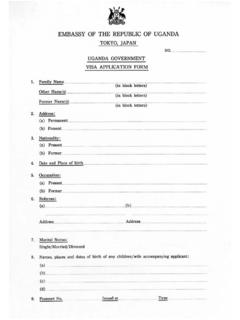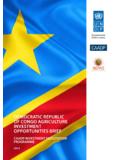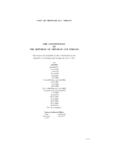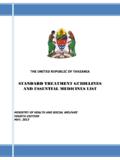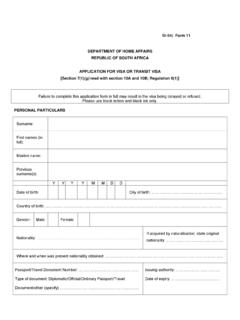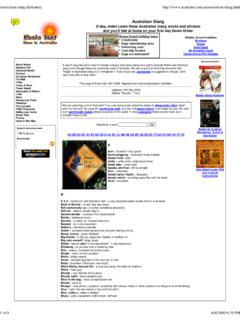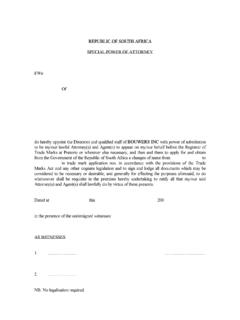Transcription of Nutrition Country Paper The United Republic of …
1 DRAFT Nutrition Country Paper The United Republic of Tanzania (Draft) CAADP Agriculture Nutrition Capacity Development Workshops February 2013 2 DRAFT Methodology and general sources used to produce this document This document has been prepared through a joint effort by technical staff from the Tanzania Food and Nutrition Center, The Ministry of Agriculture, Food Security and Cooperative, The Ministry of Health and Social Welfare, The Ministry of Education and Vocational Training, The Ministry of Community Development, Gender and Children, the UN Food and Agriculture Organisation (FAO) of the , UN REACH and other stakeholders using the sources listed below.
2 This document presents an overview of the current nutritional situation in Tanzania as well as the role of Nutrition within the Country context of food security and agriculture, including strategy, policies and main programs. The purpose of this document is to increase knowledge on the Nutrition situation, technical resources, sector programs and policies and identify the challenges and opportunities to scale up Nutrition in agricultural and food security strategies and programs. Note this document is presented as a draft, comments and corrections are welcomed. Sources Information Internet Link FAO Nutrition Country Profiles FAO Country profiles FAO STAT Country profiles UNICEF Nutrition Country Profiles MICS.
3 Multiple Indicators Cluster Surveys DHS Tanzania DHS Indicators 2010 OMS Nutrition Landscape information system CAADP Signed Compact / Investment plans / Stocktaking documents / Technical Review reports if available SUN Progress Report from countries and their partners in the Movement to Scale Up Nutrition (SUN) and WFP Food security reports WHO WHO Global Database on Child Growth and Malnutrition National Sources Tanzania Agriculture and Food Security Investment Plan Agricultural Sector Development Strategy Agricultural Sector Development Programme (2).pdf Tanzania National Nutrition Strategy Tanzania National Nutrition Strategy Implementation DRAFT Plan Key policy documents to be consulted.
4 -Tanzania Agriculture and Food Security Investment Plan -Agricultural Sector Development Programme -National Nutrition Strategy -National Nutrition Strategy Implementation Plan DRAFT -National Nutrition Policy -Council Planning and Budgeting Guideline for Nutrition -Zanzibar Food Security and Nutrition ACT 2011 -Zanzibar Food Security and Nutrition Policy -Zanzibar Food Security and Nutrition Program 3 DRAFT Introduction to the National context Table 1 Tanzania Profile Geography, population & human development Tanzania is coastal Country with many land and water resources. The population is very young with 43% of Tanzanians <15 years of age. Gross school enrollment rates for primary school in 2010 were reported at 102% (World Bank 2011).
5 Life expectancy is 59 years (World Bank 2012). HIV/AIDS prevalence among 15-49 years of age group has shown a marked decline from 7% in 2003 to in 2007, for the Mainland while in Zanzibar; prevalence had remained below 1% in the general population (WHO, 2011). Poor sanitation conditions are common both in the rural and urban areas, while access to safe water is a problem mainly for rural inhabitants. In the rural population, poverty is widespread, as approximately 40% of the population are below the basic needs poverty line, while in the urban areas approximately a quarter of the population is poor. High population growth rates imply increasing demands for social services such as sewerage, clean water, education, and accessible health care.
6 Economic Development Agriculture is a key sector of Tanzania s economy and accounts for of Tanzania s GDP. Any improvement in overall economic growth relies heavily on the performance of the agricultural sector. In addition, about 87% of the poor live in rural areas, and 75% of rural income is earned from agriculture. Growth in the agricultural sector has a significant potential to reduce poverty. Annual average GDP growth has been between 5-7% in recent years. The drivers of growth over the past decade have been mining, construction, communications, and the financial sector. Tanzania has large deposits of gold and natural gas. Manufacturing, transport, and tourism have also posted solid growth rates.
7 The service sector constitutes 47% of total value-added in the economy, compared to 36% in 1990. Annual inflation fell to in 2010 from in 2009. Food Security (food availability, access, utilization, and coping mechanisms) Main indicators of the food insecurity situation include: food accessibility (quality and quantity), diversity, and utilization. The diet in Tanzania is based on cereals (maize and sorghum), starchy roots (cassava) and pulses (mainly beans). Consumption of micronutrient dense foods such as animal products and fruits and vegetables is infrequent and subsequently micronutrient deficiencies are widespread.
8 At national level, the dietary energy supply does not meet average energy requirements of the population. The government has been importing food and receiving food aid to meet its production shortfalls. Close to 40% of the population lives in areas described by the World food Program as chronic food deficit regions : where rainfall is scarce and irregular. Rural households spend up to 66% of their income on food; price volatility is a major concern. The Dietary Tanzania-Zanzibar Tanzania-Mainland Value Sources Value Sources General Indicators Population below international poverty line of US$ per day HBS 2009/10 WHO 2007 Under-five mortality rate (per 1,000 live births) 73 TDHS 2010 81 TDHS 2010 Infant mortality rate (per 1,000 live births) 54 TDHS 2010 51 TDHS 2010 Primary cause of under-five deaths due to malaria Na - 16% UNICEF 2012 Maternal mortality rate (per 100,000 live births)
9 279 MoH 556 TDHS 2010 Primary school net enrolment or attendance ratio HBS 2009/10 83% TDHS 2010 Primary school net enrolment or attendance ratio males HBS 2009/10 78% TDHS 2010 Primary school net enrolment attendance ration females HBS 2009/10 81% TDHS 2010 Primary school net enrolment -ratio of females/males 102 HBS 2009/10 100 UNICEF 2005-09 Agro- Nutrition indicators Access to improved drinking water in rural areas HBS 2009/10 45% UNICEF 2009 Access to improved sanitation in rural areas (34-57)% HBS 2009/10 21% UNICEF 2009 Food Availability indicators Average dietary energy requirement (ADER) X - Dietary energy supply (DES) in kcal/person/day OCGS-FAO-FSND 2011 Food Consumption indicators Average daily consumption of calories (WHO/FAO -55-75) OCGS 2010 Calories from protein (WHO/FAO 10-15) OCGS 2010 Calories from fat and oils (WHO/FAO 15-30) OCGS 2010 4 DRAFT diversification index is very low, as starchy foods provide almost three quarters of the total energy supply, despite the wide variety of food produced in the Country .
10 Box 1 Causes of malnutrition and food security Causes of malnutrition and food insecurity Immediate causes Inadequate dietary intake (operating at individual level), disease, Underlying causes Income poverty, inadequate care, household food insecurity, unhealthy household environment and inadequate access to health Basic causes Lack of capital ( financial, human, physical, social and natural) & the social, economic and political context Main causes of the inconsistent food availability (list non-exhaustive) climatic variability and poor infrastructure; inadequate attention paid to nutritional requirements of the population in terms of vitamins and minerals; limited accessibility to food among the population; limited diversification in the utilization of different varieties of food; widespread poverty; burden of disease; IYCF practices not optimal.










